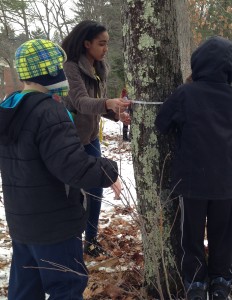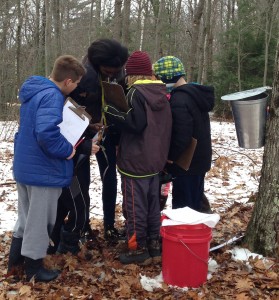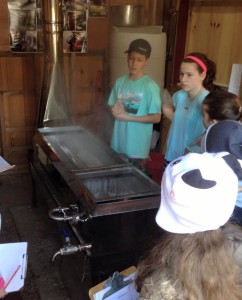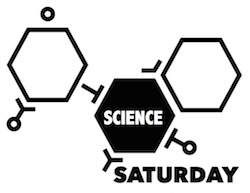Last week we looked at the sugaring operation at Essex Middle School. The students at the Edge Academy built a sugar house a few years ago, and now they produce maple syrup for their school every year. Math teacher Phil Young has intertwined the project with his mathematics curriculum, and students use iPads to support their work. By sugaring, students are engaging in the culture of their community in an authentic way. Today, I would like to share with you how these students have taken the project a step further. Not only have they learned how a sugaring operation works, they have shared that knowledge with local elementary students. This spring, The Edge invited two different classes of third graders out to the sugar house. The younger students engaged with sugaring and the math involved; the Edge students instructed them along the way, building their learning and community in the process.
Students in the third grade from Founders Memorial School were invited to come to Essex Middle during sugaring season and participate in the process. The older students described how the entire process of sugaring works. They also walked the younger students through similar math activities that they had completed. Phil created a third-grade level assignment for the visitors to complete with the help of their hosts. The younger students measured trees, timed drip rates, and calculated how much syrup they could make. The Edge students served as teachers and guides.
in the third grade from Founders Memorial School were invited to come to Essex Middle during sugaring season and participate in the process. The older students described how the entire process of sugaring works. They also walked the younger students through similar math activities that they had completed. Phil created a third-grade level assignment for the visitors to complete with the help of their hosts. The younger students measured trees, timed drip rates, and calculated how much syrup they could make. The Edge students served as teachers and guides.
Teaching expands and solidifies a students’ understanding. By teaching younger kids, the Edge students were able to deeply make sense of the sugaring process and the math involved. The field trips were beneficial for everyone involved. And the third graders got to learn about this process that is part of their culture. (Editor’s note: if you’re interested on taking your students of a field trip to the sugaring house next year, you can email Phil directly.)
 Middle grades students are in the midst of working out their own identities. The sugar house project and the experience of hosting students deeply connects them to their community, and recognizes them as sources of knowledge. Students can see themselves as part of their culture, and are experienced enough in that role to teach others. These types of experiences help students gain confidence and see themselves as experts, as well as students.
Middle grades students are in the midst of working out their own identities. The sugar house project and the experience of hosting students deeply connects them to their community, and recognizes them as sources of knowledge. Students can see themselves as part of their culture, and are experienced enough in that role to teach others. These types of experiences help students gain confidence and see themselves as experts, as well as students.
The sugaring project provided students from The Edge deep connections to their community. It provided them an opportunity to serve as teachers for younger students in their town as well.  The entire project applied numerous types of technology and math, and allowed students to understand themselves as masters of STEM. Learning opportunities like this are fantastic for young adolescents, as they are able to connect to their community and craft their own identities.
The entire project applied numerous types of technology and math, and allowed students to understand themselves as masters of STEM. Learning opportunities like this are fantastic for young adolescents, as they are able to connect to their community and craft their own identities.
Thanks again to Phil Young and Lindsey Halman for the pictures, and letting us share the story.



Sugaring and the community part 2: Students become teachers http://t.co/w1CAEnJZQc
Sugaring and the community part 2: Students become teachers http://t.co/mbQqjJWFGS via @innovativeEd
RT @mwolofson: Sugaring and the community part 2: Students become teachers http://t.co/mbQqjJWFGS via @innovativeEd
Sugaring, STEM, and the community part 2: teaching others http://t.co/Kt1nGiis7N
RT @pennybishop: Sugaring, STEM, and the community part 2: teaching others http://t.co/Kt1nGiis7N
RT @pennybishop: Sugaring, STEM, and the community part 2: teaching others http://t.co/Kt1nGiis7N
RT @mwolofson: Sugaring and the community part 2: Students become teachers http://t.co/mbQqjJWFGS via @innovativeEd